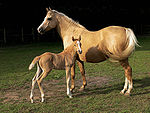- Chinese Guoxia
-
Chinese Guoxia Alternative names Guoxia, Guǒ-xià Country of origin China Common nicknames "Under the Fruit Trees Pony" Horse (Equus ferus caballus) There are many different breeds of horse in China, most of which are ancient and descended from the Mongolian horse. Although many of the breeds are small in stature, they are considered to be small horses, not ponies, and will often, when provided with good care and adequate nutrition, mature well over 14.2 hands. Many of the breeds within China bear distinct regional differences, so although they may have descended from common ancestors, they have developed differently according to their habitat and climate. However, one breed is considered an actual pony breed and this is the Chinese Guoxia, found in southwest China.
History
There is little information available regarding the breed's origins, except that it is thought to date to antiquity; a bronze statue has been recovered of a Guoxia, dated approximately 2,000 years old. Their name translated means 'under fruit tree horse', which suggests that it may have been used early on to help with working in orchards due to its short stature. The breed was largely forgotten and considered extinct. It was rediscovered in 1981, and a breed association was formed in April of that year.[1]
Characteristics
These ponies are very small in height, only reaching a maximum of 10 hands high. The Guoxia makes a very good children's pony and is useful in harness in spite of its small size. Generally it has a good temperament, quiet and willing, but is also tough and enduring. In appearance, the Guoxia bears some "primitive" horse features. . It has a small, somewhat heavy head with small alert ears. The neck is short and the back is straight and short. The shoulders are a bit straight, but the legs are well formed and strong with good hard feet. Representatives of the breed are usually bay, roan or gray in colour.
References
- http://www.petpig.com/horse/Chinese_Guoxia.aspx
- Encyclopedia of Horses and Ponies
Equine Equine science and
management
Equestrianism
and sportGlossary of equestrian terms · List of Equestrian Sports · Horse tack · Bit · Bridle · Saddle · Harness · English riding · Western riding · Driving · Horse training · Horse racing · Equestrian at the Summer Olympics (medalists, venues) · Horse show · EquitationEvolution and history Domestication · In warfare · In the Middle Ages · Horses in East Asian warfare · History of the horse in South Asia · Horses in the Napoleonic Wars · Horses in World War I · Horses in World War II · History of the horse in BritainHorse breeds, types
and other EquidaeList of horse breeds · Wild horse · Feral horse · Stock horse · Gaited horse · Draft horse · Warmblood · Sport horse · List of horse breeds in DAD-ISOther EquusHybridsCategory: Equidae 
This horse-related article is a stub. You can help Wikipedia by expanding it.
